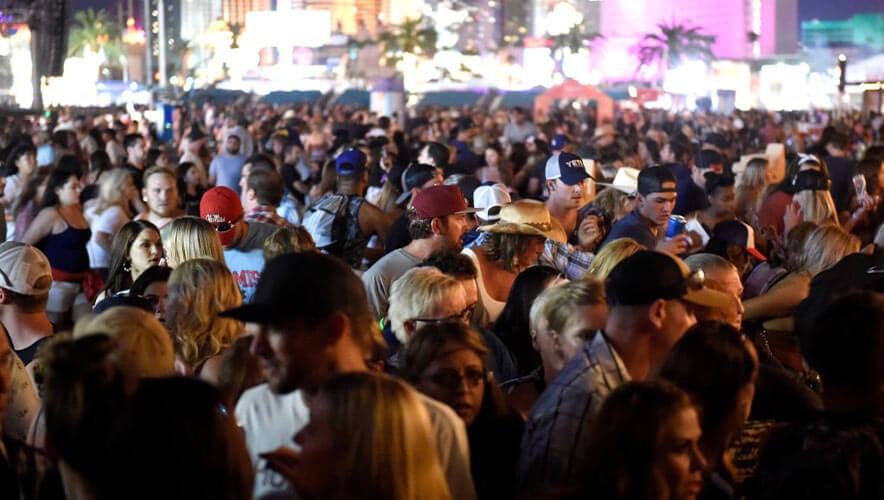Surveillance and Stereotypes
Juveniles make up 40 percent of the shoplifters in the United States. Shoplifters, in total, contribute to billions of dollars of loss each year, according to the National Association for Shoplifting Prevention’s 2014 report Shoplifting Statistics.
To combat adolescent shoplifting, according to the report, retailers depend on private security officers combined with other security measures, including security cameras, observation mirrors, and radio-frequency identification (RFID) tags.
The key to apprehending juveniles during or after shoplifting, however, is to correctly determine whom to surveil. Security personnel often rely on a combination of common underlying physical characteristics—race, gender, and age—and behavioral indices—glancing at clerks nervously, assessing security measures, and loitering—to distinguish shoppers from potential shoplifters.
Are these surveillance decisions a result of bias? To find out, the authors conducted original academic research funded by the John Jay College of Criminal Justice of the City University of New York on how stereotypes play into who is suspected of shoplifting, how that suspect is dealt with, and what private security can do to limit discriminatory practices.
EXISTING DATA
A 2003 Journal of Experimental Psychology article, “The Influence of Schemas, Stimulus Ambiguity, and Interview Schedule on Eyewitness Memory Over Time,” which discussed research findings and lawsuits against retailers, concluded that stereotypes of juvenile shoplifters may unduly influence security officers to target juveniles on the basis of their physical characteristics, rather than their behaviors.
Over the past 20 years, the media has reported on cases in which the retail industry engaged in discriminatory practices. This is known as consumer racial profiling (CRP), “the use of race and or ethnicity to profile customers.” According to a 2011 study in the Criminal Justice Review, “Public Opinion on the Use of Consumer Racial Profiling to Identify Shoplifters: An Exploratory Study,” officers sometimes use CRP to determine which juvenile shoppers are potential or actual thieves.
Most people develop negative stereotypes about juvenile thieves through exposure to various types of media, particularly when they reside in areas that contain few minorities. The media has the unique ability to both shape and perpetuate society’s beliefs about which juveniles typically commit offenses through its selective coverage of crimes.
It is also common for the media to portray adolescents—particularly boys—as criminals. Biases are then used, whether consciously or unconsciously, in the private sector by retailers and security officers to target shoppers, and in the public sector by those in the legal system, including law enforcement officers, prosecutors, judges, and even legislators, to arrest and prosecute thieves.
The consequences of applying discriminatory practices can be seen in the private sector through lawsuits against retailers. Ethnic minority shoppers purport that they were targeted through excessive surveillance—and even through false arrests.
Researchers have shown that this automated bias occurs even when observers were trained to focus on behavioral cues, and it persists despite findings that shoplifting occurs across racial and ethnic groups, according to the 2004 Justice Quarterly article “Who Actually Steals? A Study of Covertly Observed Shoplifters.”
Stereotypes also affect retailers’ decisions on how to handle shoplifters, either formally by involving the police, or informally. The results of accumulated discrimination, accrued during each step in the legal process—initial involvement of police, decision to prosecute, conviction, and sentencing—continue in the legal system. This is evidenced by the disproportionate number of African- and Latin-American boys shown in the apprehension and arrest statistics of juvenile thieves, compared to their representation in the population, according to Our Children, Their Children: Confronting Racial and Ethnic Differences in American Juvenile Justice, a book published by the Chicago University Press.
CURRENT RESEARCH
To test the premise that there is a widespread stereotype of the typical juvenile thief and shoplifter, our research team obtained information from young adults in two diverse areas: 97 psychology-major college students in a small city in the U.S. state of Kansas, and 156 security and emergency management majors at a college in a large city in New York state.
Shoplifter profile. The psychology-major students were 83 percent European American. The rest of the students were represented as follows: 5 percent African American, 2 percent Asian American, 1 percent Latin American, and 9 percent of mixed or unknown descent.
The security and emergency management major students—72 percent of whom were male—came from a variety of backgrounds: 31 percent European American, 37 percent Latin American, 19 percent African American, 9 percent Asian American, and 2 percent Middle Eastern American.
Participants in both locations were asked to guess the common physical characteristics of a typical juvenile shoplifter—age, gender, ethnicity or race, and socioeconomic status.
The stereotypical juvenile shoplifters described by both the Kansas and New York respondents were remarkably similar: male, aged 14 to 17, and from lower- to middle-class families of African-American, Latin-American, or European-American descent. The two samples also indicated that the stereotypical thief was likely to have short or medium length brown or black hair and an identifying mark—such as a piercing.
These findings show commonality in the prevalence of certain physical characteristics, despite the diversity of the two groups of respondents, and demonstrate that American society has a well-developed juvenile shoplifter stereotype.
Decision processes. After determining the stereotype, the research team considered whether juvenile shoplifter stereotypes affected respondents’ decisions. The goal was to determine the degree to which the respondents believed that physical characteristics influenced the security guards’ decisions regarding whom to surveil, and what consequences to apply when a youth was caught stealing.
The New York respondents read a brief scenario describing a juvenile shoplifter as either male or female and from one of five backgrounds: European American, African American, Asian American, Latin American, or Middle Eastern American. However, the description of the overt behaviors by the juvenile was the same for every scenario—selecting and returning shirts in a rack, glancing around the store, and stuffing a shirt into a backpack.
Respondents provided their opinions about the degree to which the security officer in the scenario relied on physical characteristics in surveilling a juvenile, and whether the retail manager and security officer should impose informal or formal sanctions on the shoplifter. Researchers reasoned that respondents should draw identical conclusions for surveillance and sanctions if they were simply evaluating the juvenile shoplifters’ behaviors, but that students would have different recommendations for these choices if their racial or ethnic stereotypes were activated.
Respondents who indicated a preference for applying informal sanctions did so more frequently for girls of African-American and Middle Eastern-American descent. These respondents also assessed that the officer described in the scenario based his or her surveillance decisions on physical characteristics. No other gender differences for race or ethnicity were notable when considering reliance on physical characteristics.
Stereotypes also affected decisions on how to sanction the shoplifter. Respondents were given the option of implementing one of four informal sanctions: speak to the juvenile, call parents to pick up the juvenile, get restitution, or ban the youth from the store. Their selection of the least severe sanction—talk to the juvenile—was doled out at a higher rate for boys than for girls of each ethnicity except European Americans, which did not differ.
The moderate level sanction—call the youth’s parents—was selected more for girls than for boys of African and Latin descent. The most severe level sanction—ban the youth from the store—was selected more for boys than for girls of African descent. However, it was selected more for girls than for boys of Asian, European, and Middle Eastern descent.
Respondents who indicated a preference for applying formal sanctions attributed physical characteristics to the guards’ surveillance decision for girls more than for boys of Latin descent; gender differences were not apparent for the other ethnicities.
Respondents were also given five formal sanctions for the youths: involve the police, prosecute the theft as larceny, impose a fine, give the youth diversion or community service, or put the incident on the youth’s criminal record. Their selection of the least severe sanction—involve the police—was endorsed more for boys than for girls of Asian, European, and Latin descent, but more for girls than for boys of African descent. No gender difference was apparent for youths of Middle Eastern descent.
The most severe sanction—diversion or community service—was preferred more for boys than for girls of African descent. A small percentage of respondents endorsed a criminal record for the theft of a shirt, but only for girls of African and European descent and for boys of Middle Eastern descent.
Finally, a comparison of our data revealed that respondents believed informal—rather than formal—consequences should be imposed for girls rather than for boys of Asian and European descent, and for boys rather than for girls of Latin descent. 
LESSONS LEARNED
Our findings clearly demonstrate that people have stereotypes about juvenile shoplifters. They also showed that people unconsciously use the typical physical characteristics of gender and race or ethnicity associated with their criminal stereotypes to make decisions and recommendations, such as whom to surveil and how to handle a shoplifting incident. Otherwise, there would not have been a difference in how the juvenile shoplifter was processed or punished, because the behaviors exhibited by all of the juveniles were identical across scenarios.
Consumer racial profiling is a defective filtering system that may direct private security officers’ attention to characteristics that are not reflective of actual shoplifting conduct. Our data suggests that CRP not only hurts retail businesses by discouraging minority consumers from shopping in their stores, but also simultaneously prevents security officers from apprehending shoplifters.
Other research, such as from “Juvenile Shoplifting Delinquency: Findings from an Austrian Study” published in the 2014 Journal for Police Science and Practice, shows that only 10 percent of juveniles are caught shoplifting. Even more disconcerting, the typical shoplifter steals on average 48 to 150 times before being apprehended. Clearly, retailers need a better strategy if they are to reduce loss due to shoplifting.
Another issue that was addressed was the decision to involve the legal system. Many businesses, despite having posted prosecution warnings, reported only about half of the adolescent shoplifters they caught to the police.
Retailers instead focus on minimizing loss and negative publicity, and may rationalize against reporting the offense to the police because they do not want to stigmatize the adolescent or because they consider it a one-time incident, particularly when the juvenile admits to the theft and then pays for or returns the items, according to the U.S. Department of Justice’s (DOJ) Community Oriented Policing Services.
These beliefs, however, may be misguided. Though current research is scarce, a 1992 study—The Sociology of Shoplifting: Boosters and Snitches Today—indicated that 40 to 50 percent of apprehended adolescent shoplifters reported that they continued shoplifting.
There are benefits for retailers who involve the legal system, especially for informal police sanctions.
First, criminal justice diversion programs and psychological treatment and educational programs treatment may reduce recidivism. For example, shoplifters who attended and completed a diversion program had significantly fewer re-arrests compared to those who failed to complete or did not attend, a DOJ study found.
Second, the private sector needs the support of the public sector to reduce shoplifting. Shoplifters can be given an opportunity to participate in first offender programs and, upon completion of classes on the effects of shoplifting, have their charges dismissed or even erased.
RECOMMENDATIONS
Retailers and private security officers need training to make them aware of their own biases and how their stereotypes affect their choices. They also need training to learn which behavioral indices are most effective in distinguishing shoppers from shoplifters.
If retailers do not make significant changes in guiding their employees—particularly security officers—towards objective measures of vigilance to prevent shoplifting, their financial loss will continue to be in the billions of dollars.
Private security officers must be taught how to treat all potential shoplifters, regardless of their gender, in the same way to prevent making mistakes and subjecting retailers to lawsuits for discriminatory security practices.
Overcoming unconscious biases is difficult. Prior to specialized training in bias identification and behavioral profiling, it is important to determine the biases of security officers. Self-assessment measures similar to the ones the researchers used in their study can be administered.
The officers should also keep records that specify each incident of shoplifting, what behaviors drew their attention to warrant surveillance, what act occurred to provoke them to approach the juvenile shoplifter, the items that were taken, the method used, the shoplifter’s demographics, how the situation was handled, who made the decision, and reasons for the decision. The officers should then review these records with their retail managers.
Retailers should also implement a mandatory training program to provide private security officers with the tools needed to identify shoplifting behaviors to increase detection and reduce shrink.
The incident records could be introduced and used to help identify the impact biases have on private security professionals’ decisionmaking about juvenile shoplifters. It would also help security guards learn the various types of suspicious behaviors that shoplifters exhibit, such as juveniles who make quick glances at staff, examine items in remote aisles, monitor security cameras and mirrors, and purposefully draw employees’ attention away from others.
Additionally, a practical component would be to show surveillance videos of the behaviors exhibited by juvenile shoplifters of different gender and race or ethnicity. In this way, the findings of past studies showing the insignificance of race, ethnicity, or gender can be learned through real-world examples.
Dr. Lauren R. Shapiro is an associate professor in the Department of Security, Fire, and Emergency Management at John Jay College of Criminal Justice. She has published several journal articles and chapters on the role of stereotypes in perception and memory for crime and criminals. Dr. Marie-Helen (Maria) Maras is an associate professor at the Department of Security, Fire, and Emergency Management at John Jay College of Criminal Justice. She is the author of several books, including Cybercriminology; Computer Forensics: Cybercriminals, Laws, and Evidence; Counterterrorism; and Transnational Security.










